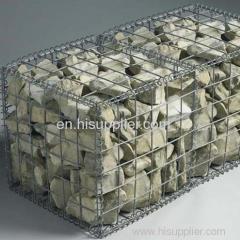
Welded Gabion
12.0~14.0 USD
| Min. Order: | 100 Set/Sets |
|---|---|
| Trade Term: | FOB |
| Payment Terms: | L/C, T/T |
| Supply Ability: | 1000 sets per day |
| Place of Origin: | Hebei |
Company Profile
| Location: | Hengshui, Hebei, China (Mainland) |
|---|---|
| Business Type: | Manufacturer, Trading Company, Distributor/Wholesaler, Service |
Product Detail
| Model No.: | WHMP-N89 |
|---|---|
| Means of Transport: | Ocean |
| Application: | Others |
| Type: | Welded |
| Material: | Others |
| Brand Name: | wanhai |
| Application:: | Welded Gabions are used in many situations including the stabilization of earth movement and erosion, river control, res |
| Advantages:: | Gabions made of welded wire fabrics offer strong strength compared with woven wire gabions while they have similar flexi |
| Production Capacity: | 1000 sets per day |
| Packing: | pallet |
| Delivery Date: | 15days |
Product Description
Description:
Gabions are rectangular baskets fabricated from a hexagonal mesh of heavily galvanized
steel wire. The baskets are filled with rock and stacked atop one another to form a gravitytype
wall. Gabions depend mainly on the interlocking of the individual stones and rocks
within the wire mesh for internal stability, and their mass or weight to resist hydraulic and
earth forces. Gabions are a porous type of structure that can sometimes be vegetated. Gabions are
considered to be a "hard" structural solution that has minimal habitat and aesthetic value.
Applicability:
Gabions are used to slow the velocity of concentrated runoff or to stabilize slopes with seepage
problems and/or non-cohesive soils. Gabions can be used at soil-water interfaces, where the
soil conditions, water turbulence, water velocity, and expected vegetative cover are such
that the soil may erode under the design flow conditions. Gabions can be used on steeper
slopes than riprap and are sometimes the only feasible option for stabilizing an area where
there is not enough room to accommodate a "softer", vegetated solution.
Gabions are rectangular baskets fabricated from a hexagonal mesh of heavily galvanized
steel wire. The baskets are filled with rock and stacked atop one another to form a gravitytype
wall. Gabions depend mainly on the interlocking of the individual stones and rocks
within the wire mesh for internal stability, and their mass or weight to resist hydraulic and
earth forces. Gabions are a porous type of structure that can sometimes be vegetated. Gabions are
considered to be a "hard" structural solution that has minimal habitat and aesthetic value.
Applicability:
Gabions are used to slow the velocity of concentrated runoff or to stabilize slopes with seepage
problems and/or non-cohesive soils. Gabions can be used at soil-water interfaces, where the
soil conditions, water turbulence, water velocity, and expected vegetative cover are such
that the soil may erode under the design flow conditions. Gabions can be used on steeper
slopes than riprap and are sometimes the only feasible option for stabilizing an area where
there is not enough room to accommodate a "softer", vegetated solution.
Advantages:
Some advantages of gabion walls are:
Ease of handling and transportation
Speed of construction
Flexibility (Gabions tolerate movement)
Permeability to water (Good drainage)
Gabions offer an easy-to-use method for decreasing water velocity and
protecting slopes from erosion.





.jpg)


.jpg)
.jpg)
.jpg)